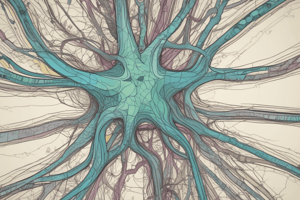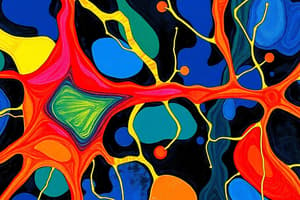Podcast
Questions and Answers
Which cellular process is MOST directly associated with the transformation of silent synapses into functional synapses?
Which cellular process is MOST directly associated with the transformation of silent synapses into functional synapses?
- Increased expression of cell adhesion molecules to stabilize the synaptic cleft.
- Secretion of factors, such as thrombospondin, from glial cells, like astrocytes and Schwann cells. (correct)
- Enhanced transport of presynaptic packets containing synaptic vesicle proteins along the axon.
- The interaction between presynaptically localized neurexins and postsynaptically localized neuroligins.
How does the modulation of cAMP levels and PKA activity affect target recognition by growth cones?
How does the modulation of cAMP levels and PKA activity affect target recognition by growth cones?
- Inhibiting cAMP levels and blocking PKA enhances target recognition by the growth cone.
- Inhibiting cAMP levels and blocking PKA mimics the effects of increased intracellular calcium, enhancing target recognition.
- Elevating cAMP levels mimics the effects of increased intracellular calcium, facilitating target recognition. (correct)
- Elevating cAMP levels inhibits PKA, which prevents the growth cone from recognizing the target.
Which aspect of neuronal function is LEAST directly facilitated by the distinct compartmentalization of a neuron into dendrites, soma, and axon?
Which aspect of neuronal function is LEAST directly facilitated by the distinct compartmentalization of a neuron into dendrites, soma, and axon?
- The neuron's capacity for directional information flow.
- The neuron's capacity to maintain a stable resting membrane potential. (correct)
- The neuron's ability to integrate synaptic signals at the soma.
- The neuron's ability to transmit action potentials over long distances.
How do cell adhesion molecules contribute to the formation of a stable and functional synapse?
How do cell adhesion molecules contribute to the formation of a stable and functional synapse?
What is the significance of the neuromuscular junction (NMJ) as a model for studying synaptogenesis?
What is the significance of the neuromuscular junction (NMJ) as a model for studying synaptogenesis?
How does the timing of presynaptic and postsynaptic differentiation contribute to the establishment of a functional synapse?
How does the timing of presynaptic and postsynaptic differentiation contribute to the establishment of a functional synapse?
Why is the rapid enhancement of synaptic transmission efficiency upon initial contact important for synapse development?
Why is the rapid enhancement of synaptic transmission efficiency upon initial contact important for synapse development?
What role do growth cones play in initiating synapse formation, beyond simply navigating to the target cell?
What role do growth cones play in initiating synapse formation, beyond simply navigating to the target cell?
Which of the following is the most accurate description of the role of electrical properties in defining a neuron?
Which of the following is the most accurate description of the role of electrical properties in defining a neuron?
How does the interaction between neurexins and neuroligins contribute to synapse formation?
How does the interaction between neurexins and neuroligins contribute to synapse formation?
Flashcards
Synapses
Synapses
Specialized junctions that allow neurons to communicate with each other and other cell types.
Growth Cone
Growth Cone
The motile tip of a growing axon that identifies the appropriate target cell and site for synapse formation.
Presynaptic Specialization
Presynaptic Specialization
Occurs when the growth cone matures into a presynaptic terminal, acquiring machinery for neurotransmitter synthesis, storage, and release.
Postsynaptic Specialization
Postsynaptic Specialization
Signup and view all the flashcards
Cell Adhesion Molecules
Cell Adhesion Molecules
Signup and view all the flashcards
Neurexin-Neuroligin Interaction
Neurexin-Neuroligin Interaction
Signup and view all the flashcards
Neuromuscular Junction (NMJ)
Neuromuscular Junction (NMJ)
Signup and view all the flashcards
Compartments of a Neuron
Compartments of a Neuron
Signup and view all the flashcards
Electrical Properties of Neurons
Electrical Properties of Neurons
Signup and view all the flashcards
Synaptic Machinery in Growth Cones
Synaptic Machinery in Growth Cones
Signup and view all the flashcards
Study Notes
- Lecture focuses on synapse formation, a critical process for establishing functional neural circuits, shifting from neuronal survival and death.
Defining a Neuron
- Neurons are defined by synapses, which are key features distinguishing them from other cell types.
- Neurons have dendrites, soma (cell body), and axon that enable directional information flow.
- Neurons utilize membrane potential and generate action potentials for long-distance signaling.
- Synapses are specialized junctions enabling neuron communication with each other and other cells like muscle cells.
Synapse Formation: A Two-Sided Story
- Requires coordinated effort between presynaptic and postsynaptic partners.
Presynaptic Differentiation
- Target Recognition: first involves the growth cone identifying the appropriate target cell and specific site for synapse formation.
- Synaptic Junction Formation: initiated by the growth cone forming a specialized junction with the target cell.
- Presynaptic Specialization: occurs when the growth cone matures into a presynaptic terminal, acquiring molecular machinery for neurotransmitter synthesis, storage, and release.
Postsynaptic Differentiation
- Afferent Recognition: requires the postsynaptic target cell to recognize and respond to the incoming growth cone.
- Synaptic Junction Formation: occurs as the postsynaptic cell participates in the assembly of the synaptic junction, aligning its cellular machinery with the presynaptic terminal.
- Postsynaptic Specialization: involves the postsynaptic site maturing to include neurotransmitter receptors, scaffolding proteins to anchor these receptors, and signaling molecules to transduce the neurotransmitter signal.
- Stable, functional synapse establishment needs bidirectional communication between pre- and postsynaptic partners.
Growth Cones: Equipped for Synaptic Communication
- Growth cones possess a basic neurotransmitter release system.
- Growth cones possess the molecular components for synaptic vesicle fusion and neurotransmitter release.
Sensing the Right Target
- Growth cones actively seek appropriate synaptic partners.
- Growth cones exhibit a surge in intracellular calcium ([Ca2+]i) upon encountering an appropriate target.
- Calcium influx is crucial for initiating presynaptic differentiation.
- Increase in growth cones can be mimicked by elevating cyclic AMP (cAMP) levels.
- Target recognition involves cAMP-dependent protein kinase (PKA).
Cell Adhesion: Bringing Partners Together
- Cell adhesion molecules physically link pre- and postsynaptic partners once the appropriate target is identified.
- Synapse formation involves NCAM, S-laminin, synCAM, cadherins, and nectins.
- These molecules stabilize the nascent synaptic junction and promote further differentiation of pre- and postsynaptic compartments through trans-synaptic interactions.
Rapid Enhancement of Transmission
- Efficiency of synaptic transmission rapidly strengthens upon initial contact.
- Enhancement due to the coordinated transport and assembly of presynaptic components.
- Presynaptic components are transported in discrete packets along the axon and these packets are stabilized at sites of synaptic contact, and this contributes to the rapid maturation of the presynaptic terminal.
Synapse-Inducing Factors: Orchestrating the Process
- Molecular cues act as potent synapse-inducing factors.
- The interaction between presynaptically localized neurexins and postsynaptically localized neuroligins is crucial for synapse formation in various brain regions, and disrupting this interaction impairs synapse development.
- The binding of presynaptic Frizzled receptors to postsynaptically secreted Wnt-7a promotes synapse formation, similarly to neurexin-neuroligin.
- Glial cells secrete factors like thrombospondin that facilitate synapse formation and convert silent synapses into functional synapses.
NMJ: A Model for Synapse Formation
- The neuromuscular junction (NMJ) is a specialized synapse between a motor neuron and a muscle fiber.
- NMJ serves as a model system for studying synaptogenesis due to its large and accessible synapse.
- NMJ uses a single neurotransmitter (acetylcholine), a single primary receptor type (AChR), a one-to-one innervation pattern, and is large compared to central synapses.
Studying That Suits You
Use AI to generate personalized quizzes and flashcards to suit your learning preferences.


